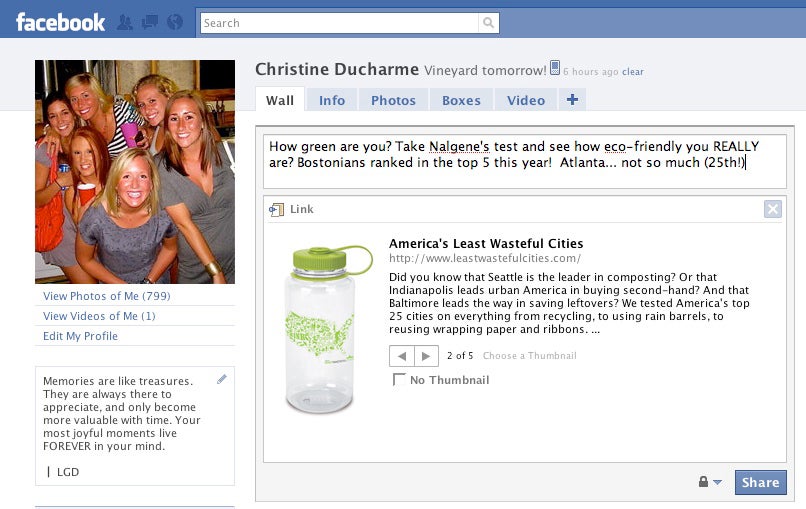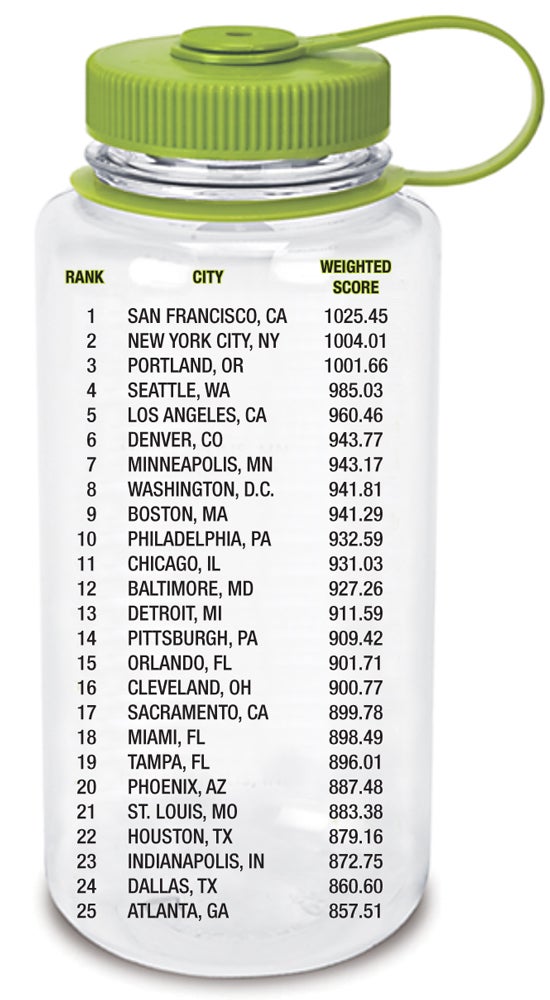Company: Nalgene
Agency: Cercone Brown & Co.
Timeframe: January 2009 - Present
Nalgene, a Rochester, New York–based maker of plastic bottles for sports and outdoor enthusiasts, faced a major crisis in 2008, as the company fought negative media coverage surrounding the use of the potential harmful chemical BPA in its products.
Though the company’s actions—including the choice to stop making products containing BPA—helped lesson the damage to its reputation, residual effects of the controversy remained, particularly online. “It wasn’t that the chatter that was so negative, it was just inaccurate,” says Len Cercone, founder of Boston-based PR agency Cercone Brown. Nalgene, who has worked with Cercone Brown since 2006, felt it needed to refocus the attention of consumers to its heritage of environmental responsibility.
The company turned to Cercone Brown to plan, develop and implement a fully integrated campaign that would strive to meet three goals, according to Len Cercone:
1. “We wanted to recast Nalgene as the “Badge of Environmental Responsibility,’” says Cercone. The message: “It’s good to make water bottles that can be refilled,” he adds.
2. “We needed to provide a conduit online to capture chatter and direct people somewhere so they could understand where Nalgene fit into the bottled water environment.”
3. “Although it wasn’t our main objective, we wanted to make a connection to Nalgene products, and create some ROI,” he says.
 |
| The Nalgene “America’s Least Wasteful Cities” Facebook page served as a major starting point for consumer conversations around their own green habits. Photo courtesy Cercone Brown |
THE IDEA
To create a viral effect, Cercone Brown set out to create a campaign that would appeal on national and regional levels. Consumers would be driven to a campaign microsite that would immerse visitors in the Nalgene brand.
Because thrift and conservation was on the minds of many Americans in late 2008 and into 2009, Cercone Brown came up with the idea to create a nationwide study that put the spotlight on wasteful behavior in major U.S. cities, while championing Nalgene as an environmental thought leader. The “America’s Least Wasteful Cities” campaign was born.
DIGITAL TACTICS
Because most of the prior damage to Nalgene’s brand was done online through blogs and social media, the campaign would be designed to flood the Internet with content that would achieve messaging objectives, while also supplanting the negative BPA content sitting high up in the search engine rankings. This would be achieved by using SEO best practices involving meta titles, mega-tag keywords and meta-descriptions. “A top PR hit used to be on top of the fold,” muses Cercone. “Now it’s on the top page of Google.”
A microsite (www.leastwastefulcities.com) was developed that would serve as a conduit between content pushed out on the Web and a destination where visitors could take their own environmental usage test, learn more about the study, and provide interesting tidbits about peoples’ green habits.
Facebook wouldbe the hub of all campaign activities, and Cercone Brown would build on Nalgene’s existing Twitter following to create conversations around the study and its findings.
MEDIA OUTREACH
A national press release timed to coincide with Earth Day would trumpet the results of the study and reveal the 25 Least Wasteful Cities. “Micro-releases” would be sent to those cities to reach local print and broadcast outlets.
In addition, Cercone Brown would try a different tack: sending letters out to the mayors of each city that made the list. “We would identify areas in the study where a city stood out, or lagged behind,” says Caroline Budney, Cercone Brown’s director of corporate social responsibility. The tactic was part of our overall strategies to work with municipalities and governments to purchase Nalgene’s products at a reduced price, she adds.
THE STUDY
The “Nalgene Least Wasteful City Study” ranked 23 waste-focused habits of urban Americans from recycling, to using public transportation, to shutting off lights. Cercone managed and analyzed the online research study, fielded by Greenfield Online, to develop content for the America’s Least Wasteful Cities campaign.
The study questioned 3,750 individuals (approximately 150 respondents from each of the 25 largest cities), gauging behavior on waste, sustainability efforts, shopping habits, transportation and reusing items. The results were weighted to give more credit to behavior that had immediate and significant impact on the planet, such as reducing driving, recycling or reducing the amount of trash.
CAMPAIGN EXECUTION
Posting the national press release on PRWeb and on the Nalgene Facebook page in the first week of April, the rankings spread across the U.S. like wildfire, with news featured on the USA Today site homepage, numerous green and news blogs, and in publications such as Fast Company and U.S. News & World Report.
“We were questioning doing broadcast outreach,” says Budney. “But we sent 25 media advisories to broadcast outlets and got 32 hits.” Budney adds that the national campaign had a grassroots feel to it, as the Cercone Brown staff split up call lists by city and pitched the story via phone to local outlets, while bloggers, Facebook and Twitter spread the results online. “It really was a good mixture of traditional and digital outreach,” she says.
Speaking of digital, as consumers reacted to the news via traditional and social media, conversations were rampant. “Twitter was clearly the center of activity, as original campaign tweets were fueled by tweets of columnists, bloggers and Facebook fans,” says Len Cercone. About 500,000 people were reached through Twitter alone.
Throughout the campaign, the message of Nalgene’s environmental dedication was linked to product awareness. Visitors to the microsite were prompted to buy a special Nalgene bottle commemorating the Least Wasteful Cities campaign, with a portion of the proceeds going to the Surfrider Foundation, which protects the world’s oceans and beaches. A link to www.filterforgood.com allowed visitors to pledge to reduce bottled water waste and study other ways to go green.
It was just the type of messaging that Nalgene was striving for, says Tiffany Teaford, Nalgene’s product manager and new product development lead. “We want to promote a environmentally friendly image, and this campaign has been successful in doing that,” says Teaford. “Plus, it gives people pause about their own actions, and allows them to communicate those actions with others.”
REFRESHING RESULTS
 |
| Messaging On a Bottle: Cercone Brown promoted the results of its America’s Least Wasteful Cities campaign (2009 rankings above) while adeptly tying in client Nalgene’s products. Source: Cercone Brown |
All totaled, Cercone Brown estimates that four million people were touched by the study news in one month, powered by nearly 50 million traditional and online media impressions.
Just as important, the campaign changed the Internet playing field for Nalgene, replacing old stories about the use of BPA in its products with new messaging that is based on its key brand objectives.
After weathering a crisis that might have put other companies out of business, Nalgene’s Teaford is satisfied with the way consumers are responding to the campaign, and how they seem to have turned their attention towards the environment. “This campaign becomes personal with consumers, and will have a long shelf life.”
While Teaford says there will always be some connection between Nalgene and BPA, the campaign’s success has helped enable the company to move on and launch newly designed products, two of which are scheduled for release this summer. “The bottom line is that Nalgene has been BPA-free since 2008, and we’re looking forward to promoting our “Made in the USA” message and broadening our current line of products,” says Teaford.
From a resource standpoint, while not revealing the campaign’s budget, Len Cercone estimates the out-of-pocket cost as $20,000-$25,000. Three people from Cercone Brown worked on the campaign, but actual hours worked were hard to estimate.
“Like any agency, this campaign wasn’t the only thing we were working on,” says Cercone. “The people here are tremendously dedicated to the work, no matter what the hours may be.”
THE CHALLENGES
Any campaign regrets? “I would have liked to have drawn more visitors to the microsite,” says Libba Cox, account executive and Cercone Brown’s social media lead. “To do that we’d have to have more components such as a mobile app and videos. But we’re working within the limitations of the budget.”
Len Cercone has no regrets, just a wish list. As the campaign is now in its second year (with San Francisco repeating as the Least Wasteful City), Cercone is hoping to expand the survey next year to a possible 50 cities. “It would be interesting to have the study reach cities with eco-friendly reputations,” he says. “How Boulder, Colorado matches up to others on the list, for example.”
Other additions to his wish list are live interviews via a satellite media tour; in-city events supported by robust marketing, and a possible lead sponsor. “I believe that if we could get retailers to take this campaign on as a cause—promoting responsible consumption—we could reach millions more,” says Cercone. PRN
CONTACT:
Len Cercone, [email protected]; Caroline Budney, [email protected]; Tiffany Teaford, [email protected]; Libba Cox, [email protected].
The Nalgene “America’s Least Wasteful Cities” Facebook page served as a major starting point for consumer conversations around their own green habits.Photo courtesy Cercone Brown
